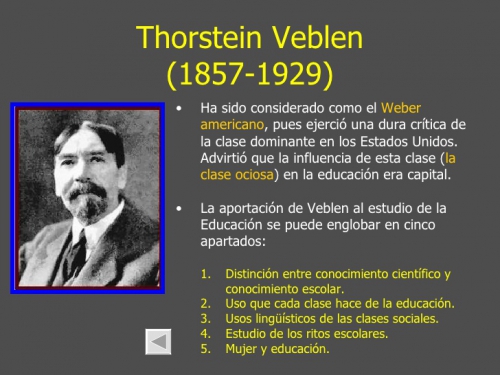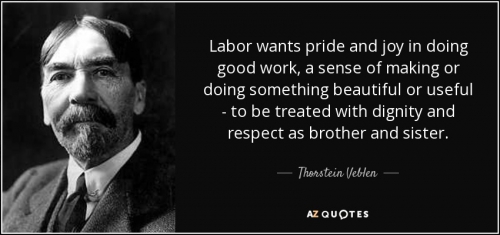
Thorstein VEBLEN
(1857-1929):
Ex: http://www.leconflit.com
Considéré comme un des penseurs de l'école évolutionniste en économie, le critique social, l'économiste et le sociologue Thorstein Bunde VEBLEN, né en Norvège, professeur dans plusieurs universités des Etats-Unis, est assez peu connu.
 Et pourtant, face aux dérives et aux échecs du néo-libéralisme, ses écrits, et notamment The Theory of the Leisure Class (1899), analyse critique de la vie sociale des hommes d'affaires, le placent parmi les auteurs qui méritent d'être redécouvert. Il a lors de son enseignement un rôle stimulant pour l'élaboration de notions fondamentales telles que celle de relative deprivation et par son ébauche des théories modernes de l'action sociale. Il écrit également dans sa sociologie critique du capitalisme d'autres ouvrages tels que Theory of Business Enterprise (1904), The Instinct of Workmanship (1914) et The Engineer and the price System (1921). (Daniel DERIVRY).
Et pourtant, face aux dérives et aux échecs du néo-libéralisme, ses écrits, et notamment The Theory of the Leisure Class (1899), analyse critique de la vie sociale des hommes d'affaires, le placent parmi les auteurs qui méritent d'être redécouvert. Il a lors de son enseignement un rôle stimulant pour l'élaboration de notions fondamentales telles que celle de relative deprivation et par son ébauche des théories modernes de l'action sociale. Il écrit également dans sa sociologie critique du capitalisme d'autres ouvrages tels que Theory of Business Enterprise (1904), The Instinct of Workmanship (1914) et The Engineer and the price System (1921). (Daniel DERIVRY).
Dans le monde francophone, le travail de ce théoricien est encore peu connu, même si la situation commence à changer. L'une des raisons de cette méconnaissance est due à un certain dédain en France envers toute pensée se réclamant du pragmatisme, made in USA. Il faut attendre les travaux sur l'habitus de Pierre BOURDIEU pour que le pragmatisme soit reconsidéré. Mais, malgré cela, trop peu d'ouvrages francophones ont été consacrés à cet auteur et peu de ses ouvrages aussi sont traduits dans notre langue. C'est surtout dans le sillage de mai 1968 et de l'intérêt porté aux théories critiques de l'économie et de la sociologie qu'un plus grand intérêt est porté à son oeuvre. Plusieurs ouvrages sont alors traduits en français : La théorie de la classe de loisir (1970), Les ingénieurs et le capitalisme (1971), qui incluent ses deux articles sur la Nature du Capital. Si la pensée de Thorstein VEBLEN commence alors à diffuser dans l'espace francophone dans les années 1970, on en retient surtout une analyse sociologique de l'ostentation et du loisir ainsi qu'une critique radicale des élites parasites, mais on continue à perdre de vue la dimension philosophique et la profondeur économique de son oeuvre ainsi que sa théorie du processus de l'évolution institutionnelle de la société. C'est seulement au tournant des années 1980-1990 qu'un véritable regain d'intérêt pour son oeuvre s'observe lorsqu'on commence à explorer les dimensions moins connues avec entre autres la soutenance de plusieurs thèses doctorales. On ne soulignera pas assez à ce propos le travail de fond de nombreux auteurs, plus ou moins importants et plus ou moins connus, qui en font connaitre d'autres, et notamment celui-ci : Dominique AGOSTINI (1987), Diane-Gabrielle TREMBLAY (1989) et Véronique DUTRAIVE en font par exemple partie. A partir de ces travaux, plusieurs chercheurs aux intérêts convergents, basés pour la plupart à Lyon, fondent le Collectif de Recherches sur l'Economie Institutionaliste (COREI) et publient un ouvrage d'introduction à l'économie institutionnelle en 1995. Une Association des Amis de Thorstein Veblen créee en 2002 et fondée par Olivier BRETTE. (Dimitri Della FAILLE et Marc-André GAGNON).
Thorstein VEBLEN estime que l'économie devrait être une science évolutionniste (Quarterly Journal of Economics, vol 12, n°4, 1898), mais si effectivement l'économie est dans la réalité un système évolutionnaire, mais ses théoriciens, à la suite de cet auteur, peinent à modéliser dans ce sens. La difficulté à laquelle les économistes évolutionnistes sont confrontés est de parvenir à développer des outils analytiques qui soient cohérents avec l'évolution, et qui permettent cependant de proposer des énoncer significatifs à propos des problèmes économiques. En général, ces outils incluent la simulation informatique, mais malheureusement, les économistes n'ont aucune formation en programmation informatique. Par chance, beaucoup d'étudiants arrivent à l'université en disposant déjà de ces compétences, et certains outils de programmation pour la modélisation évolutionnaire, tels NetLogo et Repast, sont bien plus accessibles pour eux que pour les générations précédentes. (Steve KEEN)
Le chercheur américain développe une analyse originale de la société américaine au début du XXe siècle. L'analyse vébléenne tient son originalité du regard d'étranger que pose l'auteur sur sa société ainsi que sur les sources intellectuelles diverses où puise ses influences. Son regard sur le capitalisme sauvage diffère radicalement des autres auteurs de son époque. Ses sources principales sont la philosophie kantienne, le pragmatisme, l'Ecole historique allemande, les théories évolutionnistes et le socialisme. On peut préférer l'analyse marxiste, bien plus élaborée et autant mordante, mais la sienne présente des aspects non négligeables. Ces influences lui permettent d'élaborer une théorie des institutions économiques, supérieure à bien des égards aux théories néo-institutionnalistes contemporaines, le poussant à critiquer radicalement une Amérique dominée par des institutions "imbéciles".
Alors que l'analyse marxiste présente un socle bien unifié et ramifié, les éléments de la pensée de Throstein VEBLEN sont répartis, éparpillés, dans plusieurs de ses écrits.

Marc-André GAGNON et Dimitri Della FAILLE s'efforcent d'en faire la synthèse.
S'inspirant d'Emmanuel KANT, il développe l'idée que, pour donner un sens et une cohérence à leur expérience et à leurs actions, les individus imputent pas raisonnement inductif une téléologie sur le monde qui permet de systématiser l'ensemble des connaissances et ainsi donner un sens à la vie. "Les actions individuelles peuvent donc être intentionnelles puisque la systématisation téléologique que nous posons sur le monde nous permet de déterminer un principe de causalité dans nos actions. Une telle systématisation conduit à la mise en place d'habitudes de pensé, ou institutions, qui ne sont rien d'autre que le système de sens qui sous-tend nos actions. Ces habitudes de pensée sont le matériau de base du facteur humain, dont la rationnalité n'est pas donnée dans l'absolu, mais est plutôt construite à travers les habitudes en vigueur. Avec les pragmatistes, Veblen considère que ces habitudes de pensée ne peuvent en rien prétendre à la vérité. Elles n'existent que parce qu'elles s'avèrent adaptées au milieu matériel dans lequel évolue la communauté. Mais puisque ce milieu change, les institutions se transforment aussi pour s'y adapter. L'évolution institutionnelle doit prendre en compte trois facteurs :
1 - les habitudes de pensée (institutions) ;
2 - les agents humains ;
3 - le milieu matériel.
Les trois éléments se déterminent constamment sans fin dans un processus qui n'a pas de finalité. Les habitudes de pensée déterminent les modes d'action des agents humains, constitués de la somme des individus de la communauté ; par leurs actions, ceux-ci influencent, construisent et donnent forme à leur milieu matériel ; par son évolution, ce dernier oblige l'adaptation des habitudes mentales, qui conduira à des nouveaux modes d'action, etc. Inspiré du darwinisme philosophique, Veblen considère que, puisque la vie de l'homme en société est une lutte pour l'existence, "l'évolution de la structure sociale a été un processus de sélection naturelle des institutions". L'évolution de la structure sociale est en fait "un processus où les individus s'adaptent mentalement sous la pression des circonstances". Si les habitudes mentales font que les actions individuelles sont toutes téléologiques, le processus d'évolution des habitudes mentales n'a aucune finalité en soi et évolue au rythme des contingences et des impératifs du moment.
Cette théorie de l'évolution institutionnelle distingue Veblen de l'Ecole historique allemande. Bien que cette dernière insistait sur l'importance du facteur institutionnel dans l'économie, elle ramenait toujours celui-ci à l'Etat sans être capable d'en théoriser l'évolution ; tâche à laquelle Veblen s'est attelé. Toutefois, présenté si rapidement, la théorie de Veble semble un effrayant ramassis de structurale et de déterminisme socio-biologique. Ce n'est cependant pas du tout le cas! Et ce, pour les trois raisons suivantes.
Premièrement, rappelons que dans les théories du "darwinisme social", le processus de sélection s'appliquait aux individus et légitimait de ce fait le laissez-faire et le maintien des classes laborieuses dans la misère. Veblen applique plutôt le processus de sélection aux institutions, où le laissez-faire et la légitimité de la misère doivent eux-mêmes être soumis au processus de sélection en tant qu'habitudes mentales. Bref, si dans la pensée de Spencer les individus doivent être soumis à la sélection naturelle, Veblen croit plutôt que c'est la pensée de Spencer qui doit être soumise à ce processus de sélection. De cette manière, Veble permet de remettre en mouvement la réflexion sociale et les aspirations des différentes classes sociales plutôt que de s'enfermer dans un système idéologique posé comme naturel et nécessaire.
Deuxièmement, la théorie de Veblen n'est pas une théorie structuraliste de la société. L'individu n'est pas purement et simplement déterminé par les structures sociales. S'il existe des institutions dominantes, il existe aussi des institutions alternatives, à savoir des aspirations et des modes d'action non-dominant qui remettent en cause les institutions dominantes et qui cherchent à la transformer. (...) L'individu devient acteur, il est l'instigateur (prime mover) d'un processus vivant cherchant constamment à transformer un monde qui le transformera à son tour. (...).

Troisièmement, la principale déficience des théories de l'évolution socio-institutionnelle construite sur un principe de sélection est qu'elles deviennent rapidement des apologies de l'ordre existant. En effet, si les institutions en place sont le produit d'un processus de sélection pour adapter les institutions aux réalités matérielles, il ne reste qu'un pas pour affirmer que les institutions existantes sont donc les meilleures et les plus efficientes. C'est dans ce piège plaglossien que tombent normalement les théories socio-économiques évolutionnistes comme celle de Hayek (1988) ou des néo-institutionnalistes comme Williamson (1985) ou North et Thomas (1973). Veble tombe-t-il dans ce piège? Non, au contraire, Veblen a recours à la métaphore darwinienne de la sélection naturelle justement pour éviter ce piège. (...) Pour Veblen, la lutte pour la survie ne doit pas être entendue comme une lutte pour l'obtention de biens de nécessité. Il considère plutôt que, sous les conditions modernes, la lutte sociale pour la survie est devenur une lutte pour maintenir et accroitre son statut social. (...). Les institutions dominantes dictent non seulement les modes d'action pour assurer la survie de la communauté mais aussi ceux pour se distinguer à l'égard d'autrui et dans le regard d'autrui. Les institutions peuvent donc être absolument inefficientes en termes matériels tout en nourrissant la logique d'émulation sociale. (...)" Il s'attaque, notamment dans sa Théorie de la classe de loisir, à la notion de conservatisme social entendu comme principe d'hérédité dans le processus évolutionnaire. Il considère en effet que les classes conservatrices cherchent à ralentir ou saboter le processus de sélection naturelle des institutions. Ces classes, l'élite sociale tire profit des institutions existantes et n'ont pas intérêt à les modifier. La sélection naturelle des institutions devient en fait une sélection artificielle des idées par l'élite en place, qui ne consent à une évolution des habitudes dans la communauté que si elles n'ont aucun autre choix face aux possibilités de fracture dans le système social, ou si elles peuvent elles-mêmes en tirer profit. (...)."
Marc-André GAGNON et Dimitri Della FAILLE, La sociologie économique de Thorstein Veblen ; pertinences et impertinences d'une pensée à contre-courant ; Introduction : Thorstein Veblen : héritage et nouvelles perspectives pour les sciences sociales, dans Revue Interventions économiques, n°36, 2007.
Steve KEEN, L'imposture économique, Les éditions de l'atelier, 2014.
Daniel DERIVRY, Veblen Thorstein, dans Encyclopedia Universalis, 2015.




 del.icio.us
del.icio.us
 Digg
Digg